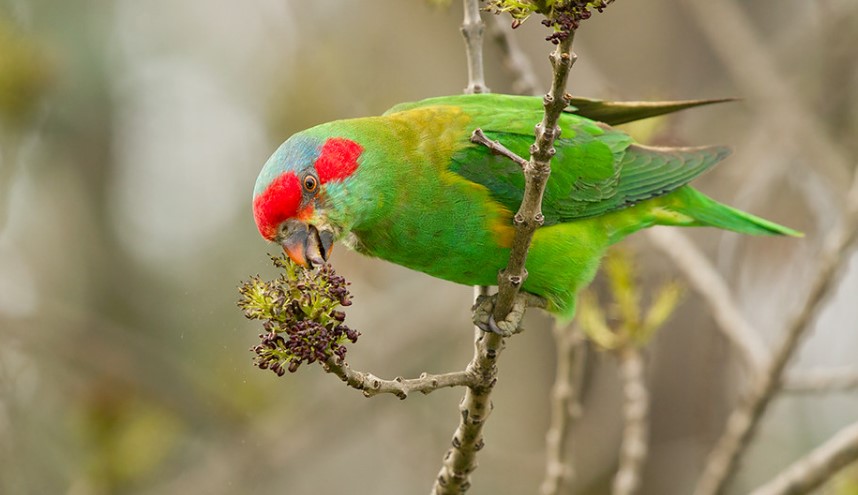Flying high above the ground on their way to and from feeding areas, Musk Lorikeet (Glossopsitta concinna) typically feeds on pollen and nectar among branches of flowering eucalypts. Green keets, red-eared lorikeets, and green leeks are other common names for this species. Musk lorikeets measure about 220-230mm in length, including the short acute tail. Among the species of Glossopsitta, the musk lorikeet is the only member.
All day long, they remain in food trees as they circle back and forth in pairs and one at a time. A constant chatter of leaves and shuffling of blossoms is the only indication of their presence. They are therefore hidden among foliage because of their green plumage. Early mornings and late afternoons are the most active times for feeding. Among their favorite foods are apricots, apples, bottlebrush flowers, nectar, and seeds from Grevillea species.

As dusk approaches, small feeding flocks converge on the main camp. During preening and face-licking, pairs cuddle up to one another. Females and males rarely nest more than once a year and make fine wood dust beds for their eggs in hollows in trees. While only the female incubates the eggs, the male appears to regurgitate food for them at night. Both parents are responsible for feeding the young. lorikeets feed primarily on nectar and pollen, like all other lorikeets.
It is believed that pollen provides most of its protein. This liquid food is easily digested by birds because they have an unmuscled stomach and an alimentary tract without a crop. It is common for Musk Lorikeets to move in relation to the blooming of trees, showing up when the trees bloom and disappearing once the trees are done blooming.
Related Reading: Little Lorikeet – Nature’s Tiny Masterpiece

Females are a little duller than males, but both are similar in appearance. The underparts are paler than the upper parts. Crown dull turquoise on forehead, lords, and band from eyes to side of neck; bronze-brown on nape and mantle tinted green. On the sides of the breast, yellow patches; on the underwing coverts, green; on the tail, green with orange-red outer feathers. It has orange eyes and a black bill with a coral tip, along with a black cere. The feet are olive and the claws are darker. Immature lorikeets have a duller appearance than adults do. The bill is black-brown with brown eyes.
Downy young are white-downed and have dull-billed bills. In 1790, George Shaw named the musk lorikeet Psittacus concinnus after a collection of birds collected near Port Jackson, in what is now Sydney. In an urbanized world, the musky lorikeet is one of the few animals that can thrive and survive. Australian cities such as Melbourne and Sydney have become home to flocks of musk lorikeets in recent decades. During the flight, a shrill metallic screech is uttered by Musk Lorikeets. Feeding is accompanied by intermittent screeching and continuous chattering.

Breeding and nesting take place between August and January. It nests in a hollow branch of a tree that is high up. Two white eggs are laid by the green keet. The eggs measure 24 mm in diameter and 24 mm in length. It takes about 22-25 days for a female to incubate. It takes six-seven weeks for the young to fledge.
Open forests, farmlands, trees along watercourses, orchards, parks, and gardens of southeastern Australia, inland to Riverina and Murray Mallee, fruit trees in the Punchbowl Area, south to Tasmania, and west to Eyre Peninsula and Kangaroo Island are all habitats for the Musk Lorikeet.
Read More – Varied Lorikeet (Psitteuteles versicolor)
